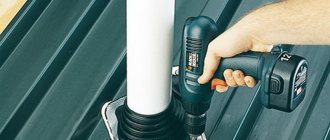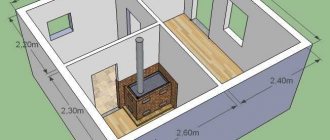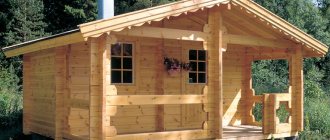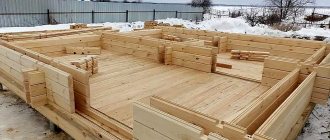A bathhouse in a private area is a functional place for recreational water treatments and family recreation.
An original and fresh solution for a suburban area located near a natural reservoir is a water bath. Modern construction technologies make it possible to quickly and efficiently erect such structures without causing damage to water sources.
Features of the construction of water baths
If the owner of the site has made the right decision to build a bathhouse on a pontoon, it is important to consider the following factors when developing a detailed design:
- It is prohibited to build water baths in environmental and protected areas. According to current legislation, such zones can occupy an area of 55 to 500 meters.
- The construction of a floating structure is permitted in cases where wastewater will be discharged beyond the established boundaries of the zone or the design provides for the additional use of septic tanks.
- When constructing a bathhouse on a private reservoir, it is necessary to provide the main method of wastewater treatment.
Important! When arranging a building on an artificial reservoir, which is private property, no permitting documentation is required.
Unusual shapes of baths
The shape and design can be the most unusual or even unexpected in its decision. So you can find a design in the form of a cable car cabin or in the shape of a pyramid. But such design options are not always aimed at getting full-fledged steam and relaxation by the water; rather, it is a way of self-expression.
Separately, we can recall the category of designs in the style of “wild nature by the water”. This can be a building in the form of a pile of stones or hidden in the crown of trees, on branches.
Baths in the form of unusual extensions in the apartment look exotic.
The design of a floating bath, its advantages
Often, a floating bathhouse differs from its land-based counterpart. The differences lie in the design itself, as well as in the technology of constructing the foundation and body.
Stationary baths are erected on pile, columnar and strip foundations. The following types of pontoons are used for the construction of floating baths:
- Made of wood. A popular version of the pontoon, which is used in areas with harsh winters and hot summers. It is more suitable for reservoirs prone to freezing in winter.
- Made of plastic. This type of pontoon is most common and is recommended for use in areas with a temperate climate - mild winters and warm summers. The plastic pontoon is lightweight, but at the same time resistant to extreme loads.
- Made of metal. Factory or homemade design, which is characterized by high cost and demanding maintenance. The metal pontoon needs thorough cleaning and regular painting.
The walls of a stationary bath are made of natural lumber, brick or wall blocks. Most often, a floating sauna is built from wood or using frame technology.
Floating baths, like stationary buildings, have many advantages, the main of which include:
- practicality;
- durability;
- frost resistance;
- wear resistance;
- attractive appearance;
- comfort;
- functionality;
- ergonomics;
- affordable price.
There are no significant drawbacks to such structures, the only thing is that it is difficult to use such a bathhouse in the winter on a frozen reservoir.
Pumps and pipes for water supply
There are a huge number of household pumps for supplying water; they differ widely in technical characteristics. When choosing a specific model and type, you need to take into account the individual characteristics of the water supply of the bath: the depth of water intake, the height of the supply, the length of the pipelines and the need to automate the water intake. Let's look at each type of pump in more detail.
Float
Float pumps
Installed on the surface of the water intake of open water sources: pond, river or well. Suitable only for summer water supply.
Float pump - photo
Disadvantages : relatively low power and lack of built-in automatic on/off systems; they can only operate at positive temperatures; they require the installation of water tanks.
Advantages - independence from the water level in the source, float pumps float on the surface of the water intake, the suction pipe is always under water, and rises/falls with it.
Submersible
Drainage submersible pump
They are immersed under water to a shallow depth, and after immersion they are fixed with stainless steel cables or strong polyamide ropes.
Pump GNOM
Advantages - can be used at sub-zero temperatures - are constantly located under the surface of the water.
This same advantage can become a disadvantage - if the water level in the source drops significantly, the suction pipe becomes exposed and the pump stops working. They are not very powerful, require separate water storage tanks, and do not have built-in control electronics.
Installation of a submersible pump in a well
Float and submersible pumps, unlike other types, can supply water with flexible hoses; they do not have lines that operate under vacuum. As for automation, you can make it yourself or purchase it separately in specialized stores. These two types of pumps belong to the cheapest category and are used mainly during the installation of a summer water supply for a bathhouse. They are easy to maintain and repair, and are always within easy reach.
The process of lowering a submersible pump into a well using a cable
Submersible pump prices
submersible pump
Pumps with hydraulic accumulators
Quite new equipment, universal use.
Pumps with hydraulic accumulators
Advantages
They have built-in automatic switching on/off depending on the pressure in the hydraulic accumulator - it is possible to connect any equipment, the water pressure is stable. They are significantly superior in power to those described above; they do not require additional water tanks. They can both suck water from a certain depth and supply it to a calculated height. When choosing a specific brand, carefully study the instructions for the pumps, pay attention to the suction depth and delivery height, these are very important criteria. Pumps with hydraulic accumulators can take water from both open sources and shallow wells.
Horizontal type hydraulic accumulator
Flaws
Quite a high cost, installation is allowed only in warm rooms. If there is a possibility of the bathhouse freezing, then you need to resolve issues with insulating the pump or drain the water from it. It takes quite a long time to drain/fill water; in addition, you will have to install additional water shut-off valves to drain water from vertical pipeline risers. Another drawback is that the units are quite noisy; constantly turning on/off the electric motor can cause a feeling of discomfort.
Deep
Deep well pump
The most expensive, reliable and powerful pumps. They are used for installation in deep wells and have their own multi-stage protection against silting and short circuits. It is not economically profitable to use only for one bathhouse; it is recommended to purchase such pumps for installing water supply in all buildings located on the summer cottage. Disadvantage : a water storage tank is required; in most cases, the Rozhnovsky water tower is used for this purpose.
Rozhnovsky water towers of various volumes
Deep pumps are lowered into wells only on metal pipes; the use of plastic ones is excluded.
Deep well pumps
Connection diagram for deep-well pump
Detailed design development
Before the start of construction work, a standard design for the future structure is developed, in which the following parameters must be taken into account:
- total area and capacity of the bathhouse;
- pontoon type and wall materials;
- drainage features;
- average monthly air temperature;
- technical characteristics of the reservoir.
For ease of implementation, it is recommended to choose a simple design of a medium-sized bathhouse with a small veranda, a combined washing room and steam room.
After preparing the project, you can begin installing the pontoon and assembling wall structures.
Installation of a pontoon for a bath
Most often, a floating bathhouse is installed on a pontoon or screw piles made of metal. The pontoon foundation is designed for artificial and natural reservoirs of varying depths. Metal piles are suitable for artificial reservoirs with a dense bottom and calm water surface.
To fix the pontoon, fastening anchors are used, and the fixation process itself is performed:
- briquettes and pipes;
- chains and weights;
- shore clamps.
Fixation with briquettes and pipes
This method of fastening involves the use of metal pipes driven 100 cm into the bottom. Installation of pipes requires the use of specialized equipment. The diameter of the supports is selected taking into account the dimensions and weight of the bath. Briquettes are attached to the installed supports, on which the pontoon is fixed.
A finished bathhouse on this basis can be used at any time of the year without the need for dismantling.
Fixation with chains and weights
The most affordable option for installing a pontoon. In this case, the sinkers are reinforced concrete piles and slabs to which chains are attached, after which they are immersed in the water near the shoreline. The pontoon base is fixed to the chains. The chains must have an appropriate length that will allow the finished structure to be freely kept afloat.
This method of fixing the pontoon involves dismantling it in winter and moving the bathhouse to a flat base.
Shore clamps
Installation of the finished structure on the shore using reinforced concrete piles, to which the pontoon is attached to metal cables or chains.
Tips for installing water supply for baths
In order for the system to serve for a long time and be reliable, you need to plan the construction of the bathhouse and water supply carefully, taking into account all the nuances.
Selection of materials
It is very important to choose the right pipes for supplying and distributing water. They must be durable, easy to install and withstand significant temperature changes.
- Steel pipes, for which there were practically no alternatives in earlier times, are practically not used today due to their instability to corrosion. They wear out quickly, and their replacement is associated with large expenses and a large amount of work.
Steel pipe after several years of use
- Polyethylene pipes are resistant to low temperatures. They are flexible and durable, easily connected using special fittings. They are convenient to use for laying summer water supply. PE and HDPE pipes do not require preservation; it is enough to simply drain the water from them for the winter.
Polyethylene pipes and fittings
- Polypropylene pipes are indispensable for the installation of external underground water supply and internal wiring. They are securely connected by soldering.
Glass fiber reinforced polypropylene hot water pipes
- Copper pipes are the most expensive. They have excellent performance characteristics. Their main area of application is a hot water supply system in a bathhouse with a remote hot water tank.
Copper pipes in the bath
Installation features
The pipeline must be protected from external influences and soil pressure. To prevent pipes underground from receiving mechanical damage, the instructions recommend laying them on a sand bed or placing them in a corrugated hose of a suitable cross-section.
This will prevent them from being deformed and compressed by the layer of soil located above, and will protect against its seasonal movements.
In order to have access to a sauna throughout the year, the water supply in winter needs to be protected from freezing. And first of all, this applies to complex pumping equipment.
- If the pump is submersible, it is in the water. It can freeze only in severe frosts if it is standing close to ground level. In this case, it is necessary to insulate the outer walls of the well and equip it with a lid.
Warm cover for the well
- The presence of a pumping station will require the installation of a caisson or an insulated pit in the bathhouse.
Insulated caisson
- Any system must have drain valves to be able to completely drain water from equipment and pipes during extreme cold weather.
Faucet for draining water to the street











